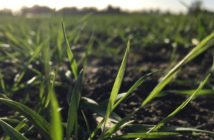Accurate testing of residual soil nitrogen could prove invaluable this season after some unexpected results last harvest, says leading agronomy firm Hutchinsons.
Wheat yields were generally better than expected in 2014 while oilseed rape was more mixed, which means there could be some considerable variation in the amount of residual nitrogen remaining for crops this season, says the firms technical manager Dick Neale.
The key is to weigh up what happened last season in terms of yields (of both grain and straw), how much nitrogen has been extracted and how much has already been returned to the soil through chopped straw, additional organic matter or fertiliser, he says.
“If you are growing second wheat after a high-yielding first wheat that did 11-12t/ha, for example, the soil is likely to be quite depleted of nitrogen. In contrast, a lot of oilseed rape did not yield as well as expected in 2014, so has not extracted as much nitrogen as normal, which should leave a decent amount behind for any first wheat.
“It is an ideal year for N-min testing, particularly after crops that have potential to return or extract a high level of nitrogen. It gives you an extra management tool, in addition to RB209, that helps you be more confident as to exactly how much nitrogen is available after an unusual season and, importantly, where it is in the soil profile.”
Indeed, a number of oilseed rape crops established well this autumn with a Green Area Index (GAI) of 1.5-2 going into the Christmas/ New Year period, but Mr Neale believes they may have simply extracted a lot of the residual nitrogen in the upper soil profile and there may not necessarily be the nutrients available at lower depths to sustain adequate growth in the spring.
Likewise, RB209 figures may suggest there is, for example, 60kg/ha of nitrogen in the soil after the following crop, but that could be mostly in the lower 60cm profile, out of reach of most roots that are still only in the 20-30cm zone, he says.
“If you don’t know where the nitrogen is in the profile and when the plant will be able to access it, you cannot react with the appropriate inputs,” Mr Neale continues.
“Don’t assume that just because a crop looks quite forward now, then you need to starve it of nitrogen later, or vice versa. It’s far better to get an N-min test done and find out exactly how much nitrogen there is and where it is in the profile, then formulate a fertiliser plan based on that information.
“A couple of N-min tests cost less than a tonne of fertiliser and will easily pay for themselves by allowing you to react at the optimum time with the most appropriate rates.”
More accurate fertiliser strategies could also help manage weed burdens in the spring, notes Mr Neale. Weeds such as cleavers and wild oats for example, are stimulated by high levels of available nitrogen, so more tailored fertiliser applications could help reduce such problems, he suggests.



